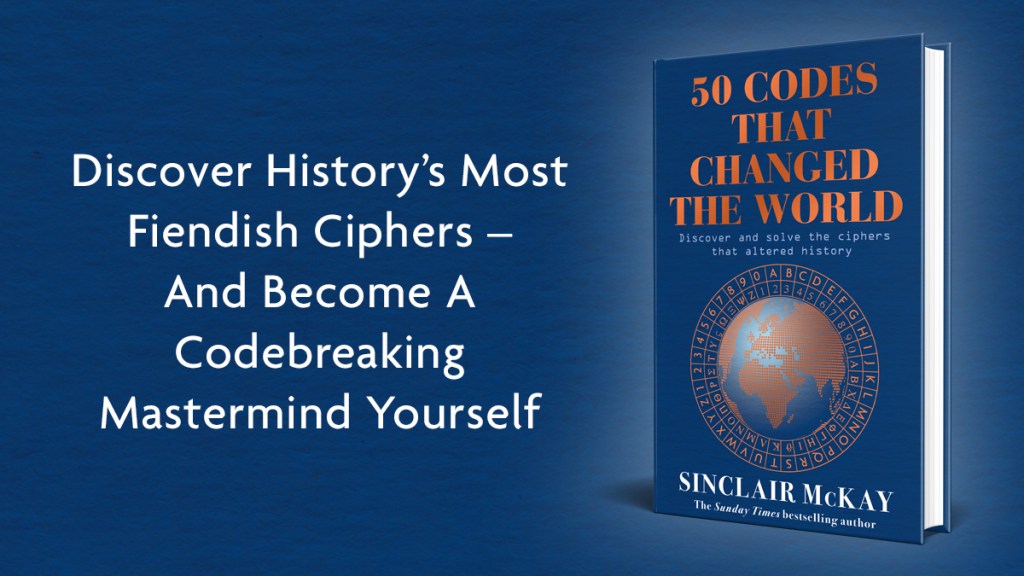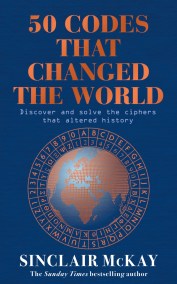Extract from Sinclair McKay’s 50 CODES THAT CHANGED THE WORLD

Introduction
Just by the mere act of reading this sentence you have successfully broken a code. All languages are ciphers in a way. Alphabets, grammars and vocabularies – their meanings remain hidden until we can read them. But of course, the purpose of language is clarity of communication and meaning made plain. Whereas the history of codebreaking, in stark contrast, is the story of languages seen through a glass darkly, distorted and obscured, reduced to base constituents of incomprehensible gobbledegook.
For practically as long as there has been writing there have been those – from spies to court officials to mystics – who have sought to disguise their words so that only the initiated could read them. Codes are fundamentally about secrets, and the world has always needed secrets. From the earliest ciphers used by the Ancient Greeks to the quantum-computing wonders of today, the principle has always remained the same. Those wishing to keep their secrets well hidden must find a way to radically disguise and rearrange sentences and letters so that their opponents or rivals cannot detect any method of unscrambling them.
Perhaps the most famous encryption technique of all was the one that was utilised through the German Enigma machine in the Second World War, where electrically generated ciphers were created by a simple-looking portable device of Bakelite and brass with a keyboard and lights. These machines were capable of producing potentially millions upon millions of different code combinations, and the story of how they were secretly defeated – first by Polish mathematicians and then by a brilliant team based at a country house in Buckinghamshire – is rightly celebrated today. But there are so many other instances, throughout history, where codes have proved to be turning points for humanity.
As well as the hieroglyphs found on Ancient Greek and Ancient Egyptian tombs, which remained baffling mysteries for many centuries after those stones were sealed, we find elaborate codes in the Old Testament, ciphers in wide use among Caesar’s armies, and even rich and strange carvings on moorland standing stones that conveyed cryptic messages to Vikings. There were codes in the violent courts of the Tudor monarchs and in the conspiracy-filled corners of the Vatican. There were cipher geniuses emerging from the young Islamic civilisation in Babylon, encryption techniques devised amid the art and the splendours of the Renaissance, and codes used as tools in an era of rapacious empire-building that swallowed the world. From Mary, Queen of Scots to Mata Hari, we find an extraordinary underground river of history where crucial moments rested upon secret codes. We also discover how ciphers were used fordifferent, more passionate purposes. Codes of love can be found across continents and times, located in the Kama Sutra or used by the famous eroticist Casanova.
And the story includes many other miracles of Second World War codebreaking performed at Bletchley Park: astounding breakthroughs achieved not by machinery but by the fizzing, dazzling creativity of the minds of the young women and men who were brilliant at maths and linguistics, and supertalented when it came to turning problems on their heads. The unravelling of the Nazi codes was more than just a wonkish intellectual triumph. This particular miracle, performed over and over again, had the most direct effect on all theatres of war and saved literally uncountable lives.
One of the continually marvellous elements of the codebreaking story is just how innocent and simple some of these ingenious encryption techniques were. You will see soon the elegance of the Polybius Square, the beauty of Dr Dee’s rotating cipher discs and the baffling wonder of Playfair – a Victorian cube of letters said to be straightforward enough for schoolchildren to master, if not diplomats! Even the Ancient Greek ruse with hexagonal rods and strips of leather with letters written on them is ingenious and offers us a fresh glimpse into lives that are otherwise shrouded in the dust of history books.
But there are stranger depths to be explored as well, with codes that take us into the uncanny realm of mysticism and ciphers that speak of philosophy. What was the lost language of the angels? And who would dare to decode it? What was the truth of the messages that genius inventor Nikola Tesla received from the depths of space? Did encrypted documents discovered within an old French chapel prove an extra dimension to Christianity that sinister forces had spent centuries trying to suppress? And back on the mortal plain, there were codes in history that spoke of unfathomable courage, such as the special poem ciphers devised for the brilliant female agents of the Special Operations Executive in the Second World War. These are now intensely poignant and they serve as tributes to bravery and sacrifice that very few would have been capable of. There is the story of how a trio of sailors in violent seas dived into a stricken, sinking German submarine in order to capture its codebooks and Enigma machine, an act of nerve that helped turn the Battle of the Atlantic.
There are codes that have transformed the way that we all live. It was almost 200 years ago that a rather talented portrait artist had an idea for sending messages right the way across a continent in the blink of an eye, but which necessitated letters being transformed into encoded sounds. His name was Samuel Morse, and the code to which he gave his name is still in use even in our digital age. There are other sorts of codes too – including those that make up all the elements of our DNA. The unravelling of the genome code in recent years has already proved a revolution in medicine.
Codes, it’s clear, are frequently accompanied by wonderful stories and eccentric characters. But it’s one thing to learn of the code and another to actually solve it. The best way to celebrate these fantastic decryption achievements is to set a few tests and puzzles of our own along the way. A few will involve actual codebreaking techniques as devised by a variety of figures from around the world, some will be based upon the fearsome challenges that were posed during the world wars, and many others will be tests of mental agility and gymnastics of the type relished by cryptologists. Codebreakers through the ages have been noted for feats of logic and lateral thinking, an ability to hold abstract theories or calculations in their heads as they try different ways to crack problems. The puzzles we have assembled here encompass all the skills and disciplines required for cryptology.
Here, then, is a parallel history of the world and indeed of the written word. Running like hidden networks through all the lands of the world, from the rich red sands of the Silk Road to the glories of Ancient Persia, from the frozen steppes of Russia to the manicured affluence of mid-twentieth-century Washington DC. These stories of those who devised the most fiendish of ciphers, and the stories of the geniuses who used incredible skill to thwart them, run alongside many of the key developments of the last two or even three thousand years. Discover the codes that changed the course of history and the encryptions that changed the nature of civilisations – tales once firmly hidden from view, now brought into the light.
A CUNNING CHRONICLE OF THE 50 CODES THAT ALTERED THE COURSE OF HISTORY AND CHANGED THE WORLD
From the bestselling author of Bletchley Park Brainteasers and The Scotland Yard Puzzle Book.
There have been secret codes since before the Old Testament, and there were secret codes in the Old Testament too. Almost as soon as writing was invented, so too were the devious means to hide messages and keep them under the wraps of secrecy.
In 50 Codes that Changed the World, Sinclair McKay explores these uncrackable codes, secret cyphers and hidden messages from across time to tell a new history of a secret world. From the temples of Ancient Greece to the court of Elizabeth I; from antique manuscripts whose codes might hold prophecies of doom to the modern realm of quantum mechanics, you will see how a few concealed words could help to win wars, spark revolutions and even change the faces of great nations.
Here is the complete guide to the hidden world of codebreaking, with opportunities for you to see if you could have cracked some of the trickiest puzzles and lip-chewing codes ever created.
-----------------------
Praise for Sinclair McKay's books:
'This book [The Secret Life of Bletchley Park] seems a remarkably faithful account of what we did, why it mattered, and how it all felt at the time by someone who couldn't possibly have been born then. - THE GUARDIAN
[Bletchley Park Brainteasers] is outrageously difficult but utterly fascinating. - THE EXPRESS
'Sinclair McKay's account of this secret war of the airwaves in [Secret Listeners] is as painstakingly researched and fascinating as his bestselling The Secret Life Of Bletchley Park, and an essential companion to it.' - DAILY MAIL





